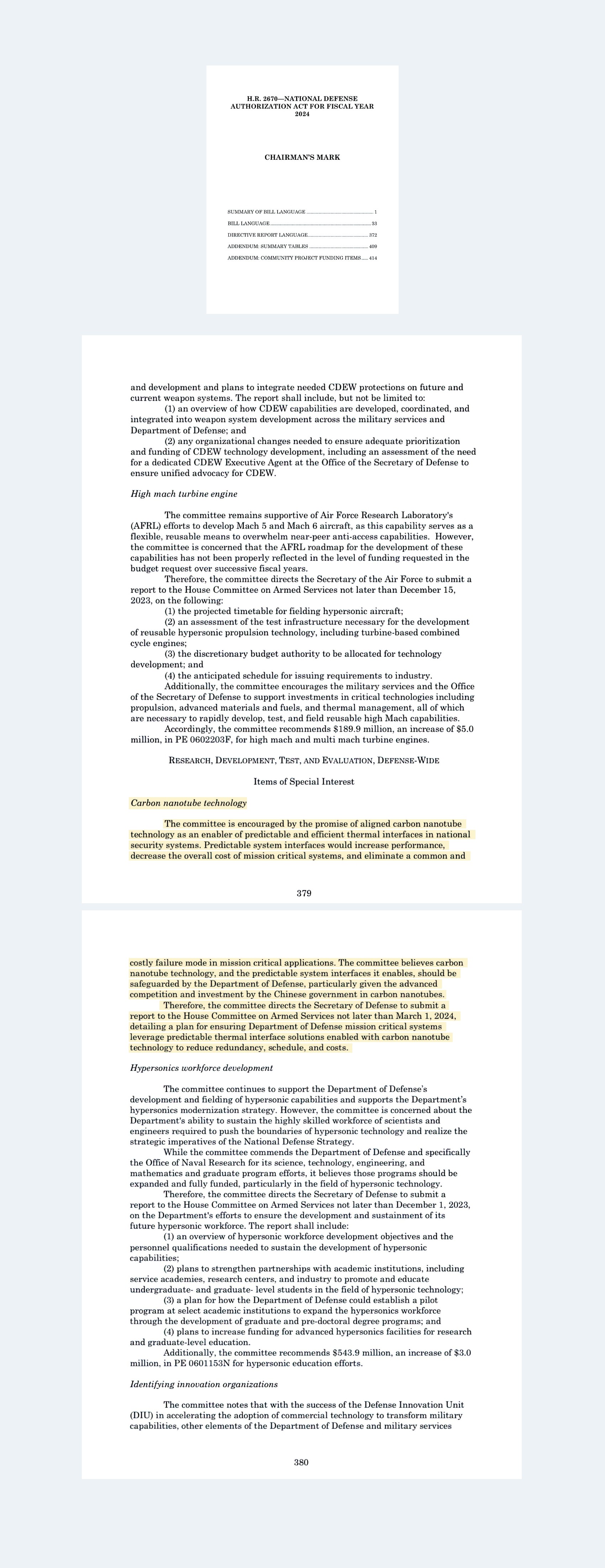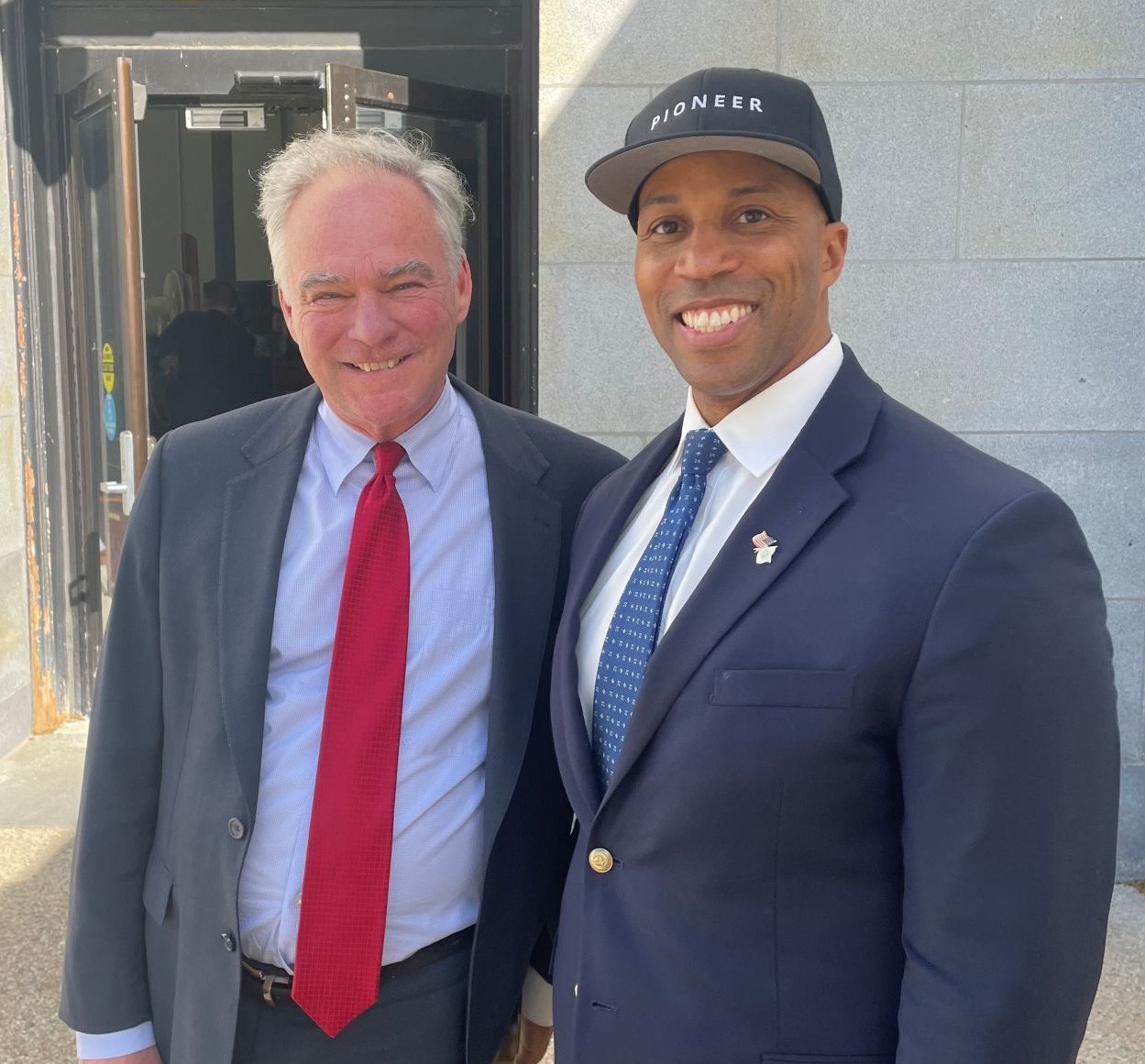Aligned carbon nanotubes (CNTs) recognized as a technology of interest for mission critical applications in U.S. security systems.
The U.S. #HASC (House Armed Services Committee) recently passed the #NDAA (National Defense Authorization Act) in a 58-1 bipartisan committee vote. Within this House defense bill: aligned carbon nanotubes (#CNT) are featured as a technology of interest for U.S. mission critical applications in national security systems.
Per the RESEARCH, DEVELOPMENT, TEST, AND EVALUATION, DEFENSE-WIDE direction of the 2024 NDAA:
“The committee is encouraged by the promise of aligned carbon nanotube technology as an enabler of predictable and efficient thermal interfaces in national security systems. Predictable system interfaces would increase performance, decrease the overall cost of mission critical systems, and eliminate a common and costly failure mode in mission critical applications. The committee believes carbon nanotube technology, and the predictable system interfaces it enables, should be safeguarded by the Department of Defense, particularly given the advanced competition and investment by the Chinese government in carbon nanotubes.”

With the passing of the 2024 NDAA in the House, informed experts have elevated aligned carbon nanotubes (#CNT) solutions as a major #defenseinnovation that strengthens thermal, electrical, and electromagnetic protection systems for critical #DoD platforms and systems.
Why is this relevant? What mark will it make in science, in the U.S.?
For Carbice, the inclusion of aligned CNTs in the NDAA is a national milestone that we can leverage to build further awareness and drive adoption of our predictable and efficient system interface solutions. Based on vertically aligned carbon nanotubes, Carbice pads eliminate the mechanical failure mode of interfaces and reduce build time, testing requirements, and cost. Currently used in space as a TRL 9 qualified advanced material solution across 20 mission-critical satellites, the technology is already positively impacting interface performance and strengthening U.S. #satellite systems, with additional applications for power electronics and data centers.
For U.S. citizens, it shows a clear example of taxpayer funds being used to create breakthrough technological innovation. Carbice was borne from and funded by the support of Defense Advanced Research Projects Agency (DARPA), National Science Foundation (NSF), U.S. Air Force Research Labs and Army Research Labs.
For the larger scientific community, it is a strong recognition of the continued promise of nanotechnology, especially Carbon Nanotubes, to solve some of the most challenging technological problems of our time.
And for the U.S., it is the promise of this #newscience and technology not only to solve challenges but to strengthen and protect us further from growing threats on earth and in space. As Nathan Diller noted in his recent post, “The House Defense Appropriations Act could be a key milestone in empowering our warfighters, acquirers, and engineers to move with urgency.”
An accomplishment at this level is the result of dedication and diligence, and we’re deeply grateful for the many people who saw, as we do, the value in the technology and helped elevate aligned #CNTs as a critical #defensetechnology.
They include members of the House and Senate Armed Services Committees as well as members of Congress, who were kind enough to hear from Carbice in this process, including Senator Raphael Warnock, Jamal Halley, Congressman Sanford D. Bishop, Jr., Senator Tim Kaine, Mike Henry, Congressman Richard McCormick, MD, MBA, Max Berry, Senator Kevin Cramer, Hakela H., Jarrod Heffley, Colby Kuhns, Senator Angus King, Jeff Bennett, Senator Roger Wicker, Emily Allegrezza, William Kamm, Senator Deb Fischer, Joshua Haynes, Senator Dan Sullivan, Chadd Montgomery, Patrick Homeyer, Cooper Cheetham, Senator Tammy Duckworth, Mike Knapp, Senator Jacky Rosen, Rachel Roberts, Senator Mark Kelly, Ashley Daniel, Senator Gary Peters, Nicole Meservey, Senator Tommy Tuberville, Michael Hart, Senator Ted Budd, Ryan Alban, Congressman David Scott, Christofer Horta, Congresswoman Nikema Williams, Nick Pennington, Congressman Rob Wittman, Hallie Coyne, Congresswoman Elise Stefanik, and Jim Robertson.

Left to right: Carbice's Rafael Spears; Georgia Congressman Sanford D. Bishop, Jr.; Carbice Founder and CEO, Dr. Baratunde Cola

Georgia Congressman Richard McCormick, MD and Carbice's Dr. Baratunde Cola

U.S. Senator Tim Kaine and Carbice's Dr. Baratunde Cola
They include fellow scientists and engineers including Branden Brough and Quinn Spadola of the National Nanotechnology Institute.
… as well as all of our investors, partners, and supporters who recognize and support the role we are already playing with #CarbiceNanotubes to make critical systems stronger, more predictable and more resilient. Together, we can #BuildStronger and #AchieveMore.
